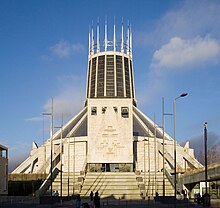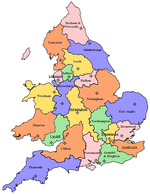Roman Catholic Archdiocese of Liverpool
Archdiocese of Liverpool Archidioecesis Liverpolitana | |
|---|---|
Patrick Kelly Thomas Williams | |
| Map | |
 The Archdiocese of Liverpool shown within the Province of Liverpool, also known as the Northern Province | |
| Website | |
| liverpoolcatholic.org.uk |
The Archdiocese of Liverpool (
History
With the gradual abolition of the legal restrictions on the activities of Roman Catholics in England and Wales in the early 19th century, Rome decided to proceed to bridge the gap of the centuries from Queen
One of these was the diocese of Liverpool. Initially it comprised the Hundreds of
]In the early period from 1850 the diocese was a suffragan of the
Location
The archdiocese covers an area of 1,165 km2 (450 sq. mi.) of the west of the County of
The central office building known as the Liverpool Archdiocesan Centre for Evangelisation (LACE). The address is LACE, Croxteth Drive, Liverpool, L17 1AA.[2] The main telephone number is 0151 522 1000.
Archdiocesan Statistics 2018
Compiled 3 December 2018
- Catholic Population 2017: 441,000
- Parishes: 157
- Priests (Diocesan & Religious): 190
- Houses of Religious Brothers: 5
- Convents of Religious Sisters: 54
- Permanent Deacons: 97
Catholic Schools & Colleges
- Primary Schools: 184
- High Schools: 27
- Academies: 7
- Sixth Form Colleges: 2
- Extra-Diocesan: 4
- Independent: 4
Archbishop and Metropolitan
On 21 March 2014 Pope Francis appointed bishop Malcolm McMahon as the ninth archbishop of Liverpool. Bishop McMahon was enthroned as Archbishop of Liverpool on 1 May 2014.
Bishop
Cathedral Church

The Liverpool Metropolitan Cathedral of Christ the King (usually shortened to
In 1853 Bishop Goss awarded the commission for the building of a new Catholic cathedral to
Following purchase of the present 9-acre (36,000 m2) site at Brownlow Hill in 1930 Sir Edwin Lutyens (1869–1944) was commissioned to provide a design which would be an appropriate response to the Gilbert Scott-designed Neo-gothic Anglican cathedral then emerging at the other end of Hope Street. Lutyens' design would have created a massive classical/Byzantine structure that would have become the second-largest church in the world. It would have had the world's largest dome. The foundation stone for the new building was laid on 5 June 1933, but again financial restrictions caused the abandonment of this plan after construction of the crypt.
The new cathedral, designed by Sir Frederick Gibberd and consecrated in 1967, was built above the crypt. Its circular plan was conceived in direct response to the Second Vatican Council's requirements for a greater and more intimate integration of the congregation with the clergy.
- "Mother Church earnestly desires that all the faithful should be led to that fully conscious, and active participation in liturgical celebrations " Second Vatican Council 1962-1965
Chapels are built in between the buttresses that support the tent-shaped spire (which represents the crown of thorns of Jesus) like tent poles. A short film, Crown of Glass, documents the construction of the cathedral's rainbow-coloured stained glass windows.
The cathedral stands on the site of the Liverpool Workhouse, on Hope Street. Facing it at the opposite end of Hope Street is the Cathedral Church of Christ, Liverpool's Anglican cathedral. Ironically, Lutyens was an Anglican, while the architect of the Anglican cathedral, Sir Giles Gilbert Scott, was Catholic.
Ministries
Youth service
Animate Youth Ministries is the youth service for the Archdiocese of Liverpool. The team, based at Lowe House, St Helens, is led by Simon Gore, and consists of a leadership team and a volunteer team all living in community together at Lowe House. Animate Youth Ministries works with school and parish groups on day retreats, mission days and mission weeks, and also holds youth Masses which take place at St Mary's Church, Lowe House, St. Helens. The Liverpool Archdiocesan Youth form an integral part of the annual Liverpool Archdiocesan Lourdes Pilgrimage. As of 2014[update], the team works with over 9,000 young people each year.[citation needed]
Missionary project
The Archdiocese of Liverpool has a long tradition of sending priests to work on the missions in Latin America, in particular Peru, This is known as the Liverpool Archdiocesan Missionary Project or colloquially as LAMP. In 2014, there were two priests involved in ministering to disadvantaged communities in Latin America, namely Simon Cadwallader and Dennis Parry.[4]
Annual Lourdes Pilgrimage
In 1923, the first official archdiocesan pilgrimage set off from Liverpool for Lourdes and continues to the present day, interrupted only by the period of the Second World War. Led by the archbishop or his auxiliary, the week-long pilgrimage normally takes place each year between the end of July and beginning of August. During the week ordinary pilgrims from across the archdiocese meet to participate in services & processions whilst assisted pilgrims are cared for by Liverpool Hospitalité members and helpers from the Archdiocesean Youth Service.
Bishops
List of Ordinaries
- Vicar Apostolic of Lancashire District
- 1840–1850: George Hilary Brown; see below
- Roman Catholic Bishops of Liverpool
- 1850–1856: George Hilary Brown; see above
- 1856–1872: Alexander Goss
- 1873–1894: Bernard O'Reilly
- 1894–1911: Thomas Whiteside; see below
- Roman Catholic Archbishops of Liverpool
- 1911–1921: Thomas Whiteside; see above
- 1921–1928: Frederick William Keating
- 1928–1953: Richard Downey
- 1953–1956: William Godfrey, appointed Archbishop of Westminster (Cardinal in 1958)
- 1957–1963: John Carmel Heenan, appointed Archbishop of Westminster (Cardinal in 1965)
- 1964–1976: AA
- 1976–1996: Derek Worlock
- 1996–2013: Patrick Altham Kelly
- 2014–present: Malcolm Patrick McMahon OP
Coadjutor Bishops
- James Sharples (1843–1850), as Coadjutor Vicar Apostolic; did not succeed to see; died before the see became a diocese
- Alexander Goss (1853–1856)
Auxiliary Bishops
- Robert Dobson (1922–1942)
- Joseph Gray (1968–1980), appointed Bishop of Shrewsbury
- Joseph Formby Halsall (1945–1958)
- Augustine Harris (1965–1978), appointed Bishop of Middlesbrough
- Anthony Hitchen (1979–1988)
- Vincent Malone (1989–2006)
- Kevin O'Connor (1979–1993)
- John Rawsthorne (1981–1997), appointed Bishop of Hallam
- Thomas Anthony Williams(2003–
- Thomas Neylon (2021–
Other priests of this diocese who became bishops
- John Patrick Barrett, appointed auxiliary bishop of Birmingham in 1926
- John Bilsborrow, appointed Bishop of Salford in 1892
- Paul Richard Gallagher, appointed nuncio and titular archbishop in 2004
- Vincent Gerard Nichols, appointed auxiliary bishop of Westminster in 1991; future Cardinal
- Thomas Edward Flynn, appointed Bishop of Lancaster in 1939
- William Godfrey, appointed apostolic delegate and titular archbishop in 1938; later returned here as archbishop; future cardinal
- Thomas Holland, appointed Coadjutor Bishop of Portsmouth in 1960
- Richard Preston, appointed auxiliary bishop of Hexham and Newcastle in 1900
William Godfrey
Vincent Nichols
John Rawsthorne
Paul Gallagher
Vincent Malone
Vincent Malone was born in Liverpool on 11 September 1931. He was ordained to the priesthood for the Liverpool archdiocese at St Oswald's, Old Swan, Liverpool on 18 September 1955. He was ordained titular bishop of Abora and auxiliary bishop of the Archdiocese of Liverpool by Archbishop Derek Worlock on 3 July 1989. It was officially announced on 26 October 2006 that Bishop Vincent Malone would be retiring as auxiliary bishop of Liverpool. In common with all Bishops he was required to submit his letter of retirement to Pope Benedict XVI on reaching the age of 75. He continued to be a vicar general, a member of the archbishop's council and a trustee of the archdiocese. Moreover, although he no longer carried out formal parish visitations, Malone continued to celebrate the Sacrament of Confirmation. Bishop Vincent Malone died on 18 May 2020, aged 88, at the Royal Liverpool Hospital, after testing positive for COVID-19.
Augustine Harris
References
- ^ Metropolitan Archdiocese of Liverpool
- ^ "Area information for L17 1AA, Liverpool, Merseyside".
- ^ Archdiocese of Liverpool 2018 Directory
- ^ "Liverpool Catholic".
Bibliography
- Burke, Tom (1910). ISBN 1408642506.
External links
- Cathedral site
- Archdiocese site
- Liverpool Archdiocesan Centre for Evangelisation
- Nugent Care website
- Animate Youth Ministries website
- Liverpool Archdiocesan Lourdes Pilgrimage
- GCatholic.org
- image of the Lutyens design Archived 9 June 2007 at the Wayback Machine (Courtesy of Dream Organs)
- Herbermann, Charles, ed. (1913). . Catholic Encyclopedia. New York: Robert Appleton Company.


